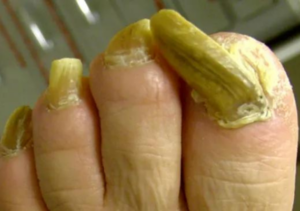Onychogryphosis, commonly referred to as “ram’s horn nails,” is a condition characterized by the abnormal thickening and curvature of the nails, usually affecting the big toes. The nails become hard, discolored, and claw-like in appearance, making them difficult to trim and maintain.
Causes of Onychogryphosis
- Trauma: Repeated injury or pressure on the toenail, often from ill-fitting shoes or direct trauma.
- Neglect: Long-term neglect in nail care can lead to severe thickening and deformity.
- Aging: Older adults are more prone to developing onychogryphosis due to reduced nail growth rate and increased susceptibility to nail disorders.
- Circulatory Issues: Poor blood circulation to the feet can contribute to nail deformities.
- Genetics: There may be a hereditary component, making some individuals more prone to the condition.
- Other Medical Conditions: Conditions such as psoriasis, fungal infections, and ichthyosis can lead to onychogryphosis.

